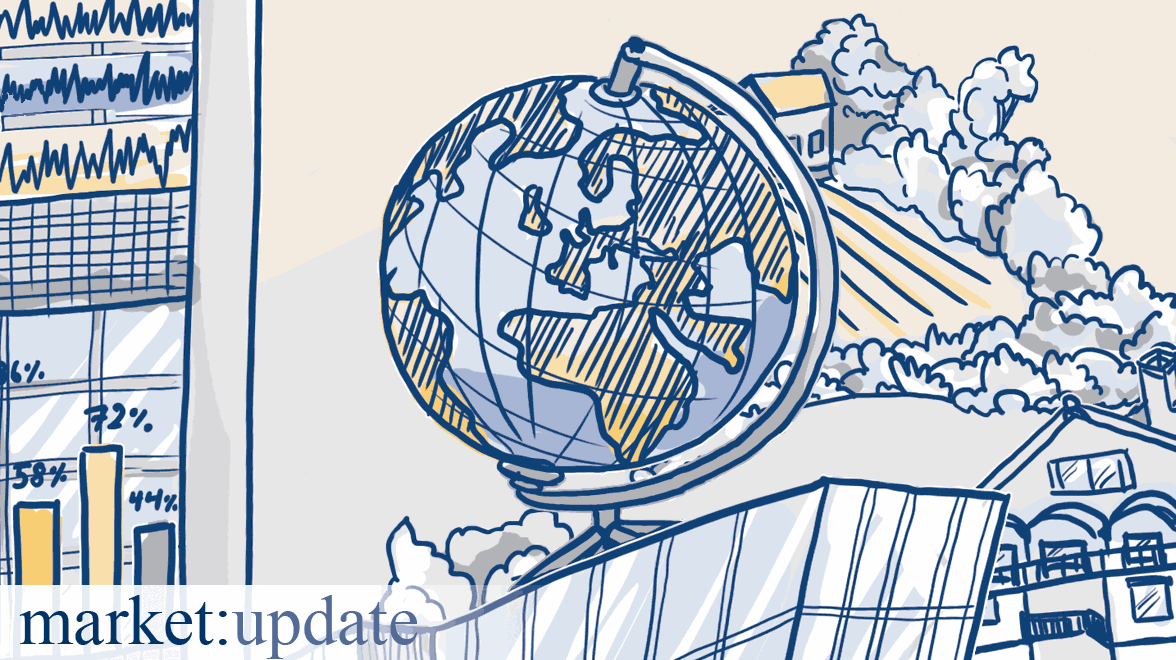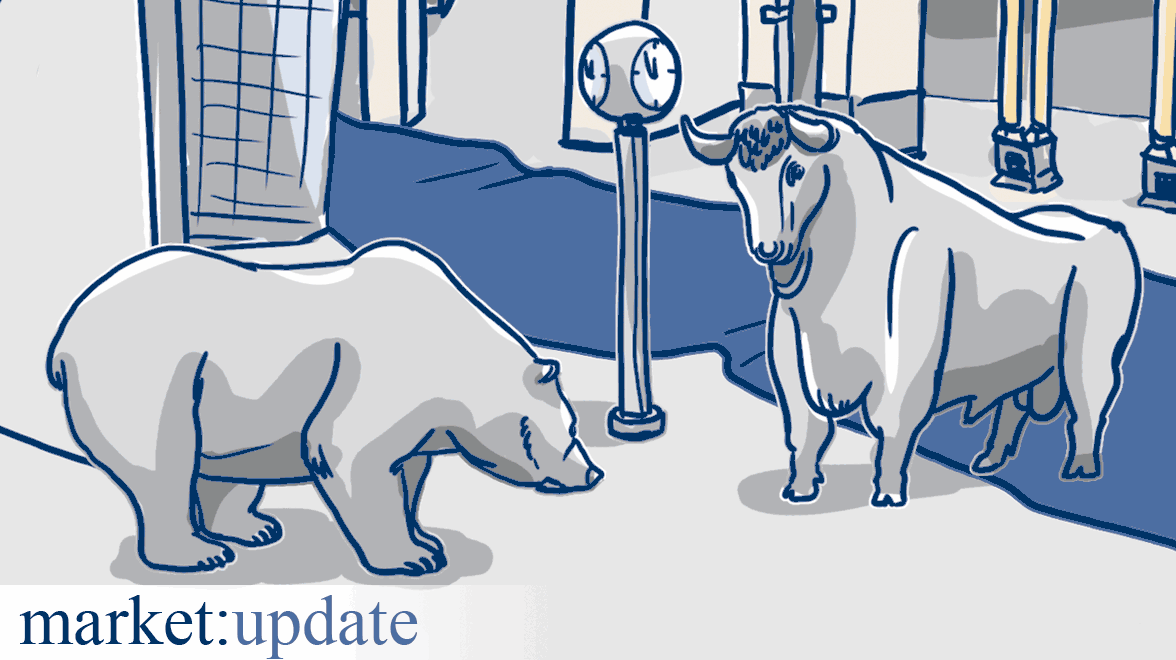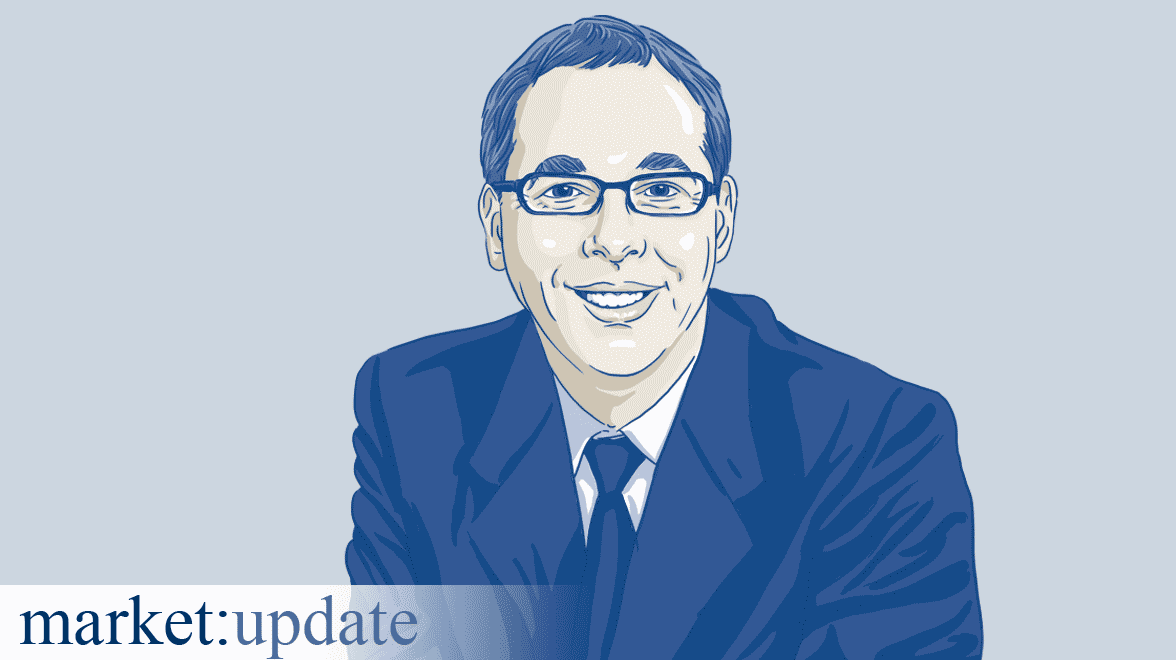Complex situation: Which path will the global economy take?
Rising interest rates – the central banks' tried-and-tested means of fighting inflation – usually slows the economy down. But so far, the exact opposite has happened. The economy is stepping on the growth pedal, cruising right past the downturn exit for the time being.
The global economy accelerates
The US Federal Reserve has been raising its key interest rate in several steps since March of 2022 and the European Central Bank (ECB) since July of 2022. The last time a comparably rapid pace of key interest rate hikes was observed was more than 40 years ago when inflation soared in the 1970s.
So far, the key interest rate has risen by 5.0 percentage points in the USA and by 3.75 percentage points in the euro zone. Standard macroeconomic models show that key interest rate hikes slow down the economy and often even lead to a recession. An economic slowdown reduces demand; thus supply and demand come back into balance and inflation can fall. According to ECB calculations, key interest rate hikes should reduce economic growth in the euro zone by around 2.0 percentage points in 2023 and 1.5 percentage points in 2024.
However, things have turned out differently than expected. Instead of a slowdown in growth, an acceleration in global economic growth has been observed since the beginning of the year. The daily indicator of global economic growth, for example, shows an acceleration from -0.3 percent at the beginning of the year to 2.4 percent by the end of April (see Fig. 1). Obviously, other influencing factors are offsetting the slowing effect of higher interest rates, including:
- The complete opening of the Chinese economy after the end of covid restrictions, resulting in a consumption boom
- Strong labor markets and rising wages worldwide
- Expansionary fiscal policy with extensive government aid during the energy crisis in Europe and Asia, as well as subsidy programs such as the Inflation Reduction Act in the US
- A global increase in the propensity to consume among wealthy households due to the pandemic and the war
- Improved purchasing power due to declining commodity prices
- Relaxation of supply chains.
Bloomberg, JP Morgan, Metzler; as of May 1, 2023
Doch es ist anders gekommen, als erwartet: Statt einer Wachstumsverlangsamung lässt sich seit Jahresanfang eine Wachstumsbeschleunigung der Weltwirtschaft beobachten. So zeigt der tägliche Indikator des globalen Wirtschaftswachstums, eine Beschleunigung von -0,3 Prozent zu Jahresanfang auf knapp unter 2,0 Prozent bis Ende Mai (s. Abb. 1). Offensichtlich hebeln andere Einflussfaktoren die bremsende Wirkung der höheren Zinsen aus, dazu zählen:
- Starke Arbeitsmärkte und steigende Löhne weltweit
- Eine expansive Fiskalpolitik mit umfangreichen staatlichen Hilfen in der Energiekrise in Europa und Asien sowie Subventionsprogramme wie der „Inflation Reduction Act“ in den USA
- Eine weltweit veränderte Konsumneigung von vermögenden Haushalten nach Pandemie und Krieg
- Eine verbesserte Kaufkraft infolge fallender Rohstoffpreise
- Eine Entspannung der Lieferketten.
Can the pace of growth be sustained in the second half of the year?
The global economy is currently influenced by many factors. The question now is how persistent or how temporary the influence of the individual factors will be. Unfortunately, there is no simple answer. Three points need to be considered here:
The first point is the credit cycle. The global economy could weaken significantly as early as the second half of 2023. Acceleration of growth in the first half of the year would then only have been an interim high, in which other influences briefly overshadowed what was the dominant factor: rising interest rates. One indicator of this is the mini-bank crisis in the USA. Due to a rise in key interest rates, investors withdrew funds on a large scale from small and medium-sized US banks and invested in money market funds. As a result, banks are noticeably reluctant to grant new loans. In Europe, too, banks are reluctant to lend because of the higher interest rates. In this scenario, economic weakness would then also be accompanied by a noticeable drop in inflation, so that the central banks could cut the key interest rate again at the beginning of 2024.
The second point is non-interest-dependent and robust demand due to the change in consumer behavior and high government spending. In particular, the high propensity to consume among high-income households, stable labor markets and fiscal support could sustain the recovery for longer. The pandemic, war, rising inflation and other crises seem to have led to a "consume now!" attitude among wealthy households. Therefore, a diametrically opposed starting position to the one before the financial market crisis in 2008 has arisen. At that time, wealthy households had a very high savings rate and thus indirectly financed the loans of less wealthy households, which were used for consumption and purchasing real estate. By contrast, we currently have a "you only live once" recovery, so to speak, which is not dependent on the credit cycle because savings among wealthy households are very high. In this scenario, however, inflation would not decline as expected but would remain high due to dynamic consumption, and central banks would have to raise the key interest rate more than expected. However, it would be impossible to avoid an interest-rate-induced downturn altogether – it would only be postponed until 2024.
Finally, the third point is productivity. Productivity growth, for example, could accelerate noticeably in the coming quarters. The reason for this is the increasing use of artificial intelligence (AI) in business operations and the automation of production processes. AI applications such as ChatGPT-4 are now already sophisticated enough to be used in the workplace. According to a study by Goldman Sachs, AI applications could be used in more than two-thirds of all jobs worldwide in the next few years. AI could take over individual tasks and, in some cases, make entire jobs redundant. Worldwide, 300 million jobs would be affected. As a result, the productivity growth rate could accelerate by around 1.0 to 1.5 percentage points – like it did in the "new economy" of the 1990s. Higher productivity growth would mean noticeably declining inflation. Central banks would no longer have to raise interest rates. However, key interest rate cuts would then not be necessary either, as the economy would be able to cope well with a higher interest rate level.
The credit cycle points to an economic slowdown
The credit cycle is clearly in a downturn in the USA and Europe. In the USA, the focus is mainly on small and medium-sized banks, whose share prices continue to be low despite the liquidity measures taken by the US Federal Reserve and the rescue of three banks. These small and medium-sized banks are extremely relevant in macroeconomic terms because they handle a large share of lending, especially for real estate (see Fig. 2). As the commercial real estate market in the USA is currently weakening as well, these banks are very concerned about running into liquidity difficulties. Securing liquidity is likely to be a focus for these banks at the expense of new lending. The weekly data on lending, for example, are already showing first significant signs of weakening.
* Includes commercial multi-family residential construction & land development, and farmland real estate loans ** Includes single-family real estate loans
In Europe, too, lending has been stagnating for several months (see Fig. 3). The ECB's key interest rate hikes have led to noticeably rising lending rates while demand for credit has weakened significantly. The credit cycle is now showing weaknesses similar to those seen in the Great Recession of 2009 and the sovereign debt crisis of 2012 when growth weakened markedly and inflation dropped.
Overall, the central banks' key interest rate hikes have left the expected mark on the credit system. No improvement is expected here in the coming months either, so economic risks remain.
Consumer sentiment paves the way for economic recovery
Nevertheless, important economic data such as the ifo index or the purchasing managers' indices have recently shown a noticeable upturn in the economy. Demand appears to be on the rise regardless of the credit cycle. Only companies with high cash holdings and private households with high assets could be behind this strong demand because they are insensitive to interest rates. Due to extensive government aid during the covid pandemic, household wealth has risen to new historic highs in many countries.
However, it is difficult to estimate how stable this demand will be over time because it is currently impossible to know whether the good consumer mood is only temporary or whether there has been a fundamental change in the attitude of the wealthy toward consumption and savings.
Base scenario: economic slowdown in the second half of 2023
However, once interest rates reach a certain level, the wealthy will also start to save more and consume less. This means that central banks would have to raise the key interest rate further in the second half of the year if there is no downturn. Further complicating the outlook is the rapid progress in AI, which could even lay the groundwork for a sustainable recovery. However, it is uncertain how quickly companies will be able to deploy and apply the new AI technologies.
In our base scenario, we currently expect the economy to cool in the second half of the year. We also expect the central banks to cut key interest rates again at the beginning of 2024. Nevertheless, we are closely monitoring further developments and keeping an eye on the alternative scenarios.
More articles
This document published by Metzler Asset Management GmbH [together with its affiliated companies as defined in section 15 et seq. of the German Public Limited Companies Act (Aktiengesetz – "AktG”), jointly referred to hereinafter as “Metzler“] contains information obtained from public sources which Metzler deems to be reliable. However, Metzler cannot guarantee the accuracy or completeness of such information. Metzler reserves the right to make changes to the opinions, projections, estimates and forecasts given in this document without notice and shall have no obligation to update this document or inform the recipient in any other way if any of the statements contained herein should be altered or prove incorrect, incomplete or misleading.
Neither this document nor any part thereof may be copied, reproduced or distributed without Metzler‘s prior written consent. By accepting this document, the recipient declares his/her agreement with the above conditions.
 Deutsch
Deutsch English
English


